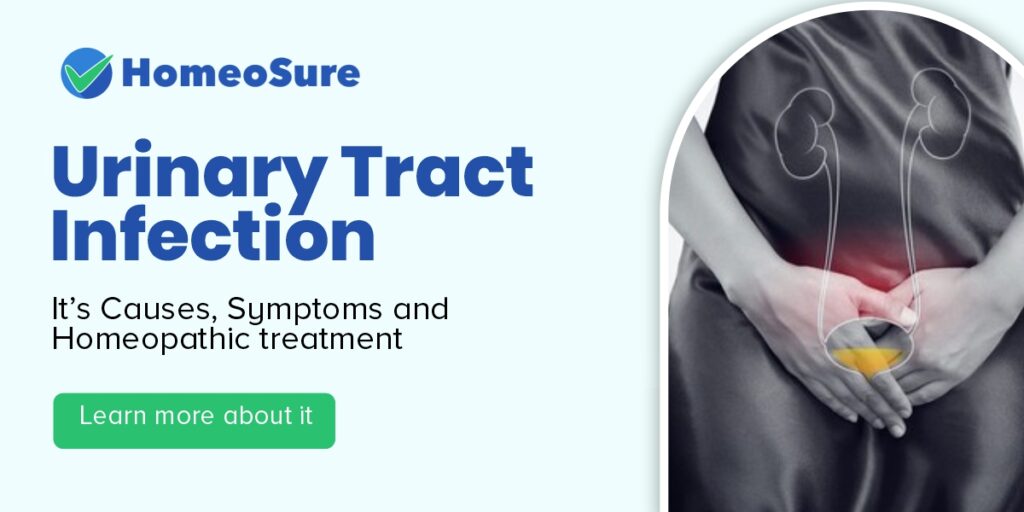Urinary Tract Infection
Urinary tract infection (UTI) is an infection of the urinary system involving kidneys, ureters, bladder and urethra. Mostly infections involve the lower urinary tract – bladder infection and urethral infection. Inflammation of the bladder is known as Cystitis and inflammation of the urethra is Urethritis.
CAUSES OF URINARY TRACT INFECTIONS
Most urinary tract infections (UTIs) are caused by bacteria that live in the digestive system. If these bacteria get into the urethra (the tube where urine comes out), they can cause infection.
It’s thought the bacteria can spread to the urethra via the anus. For example, if toilet paper touches your anus and then touches your genitals, the bacteria can multiply and move through your urinary tract, causing infection of your:
- Urethra (urethritis)
- Bladder (cystitis)
- Ureters (ureteritis) – the ureters are tubes that run from the bladder to the kidneys
- Kidneys (pyelonephritis)
Women are more likely than men to have a UTI. This is because in women, the urethra is closer to the anus than it is in men. Also, the urethra is much shorter in women, making it easier for bacteria to reach the bladder.
RISK FACTORS FOR URINARY TRACT INFECTIONS
- A condition that obstructs or blocks your urinary tract, such as kidney stones
- A condition that prevents you fully emptying your bladder (it’s easier for bacteria to multiply if urine stays in the bladder for too long)
- A weakened immune system – from chemotherapy or HIV, for example
- A urinary catheter – a tube inserted into your bladder to drain away the urine
Further risk factors in women – Women are also more likely to get a UTI if:
- They’re sexually active – having sex can irritate the urethra, allowing bacteria to travel through it more easily and into the bladder
- They use a diaphragm for contraception, as a diaphragm can put pressure on the bladder and prevent it emptying properly
- They use condoms coated in spermicide, as spermicide can irritate the vagina, making it more vulnerable to infection
Further risk factors in men – Men are also more likely to get a UTI if:
They have an enlarged prostate gland – this can put pressure on the bladder and urethra, preventing the bladder emptying properly
SYMPTOMS OF URINARY TRACT INFECTIONS
- A burning feeling when you urinate
- A frequent or intense urge to urinate, even though little comes out when you do
- Pain or pressure in your back or lower abdomen
- Cloudy, dark, bloody, or strange-smelling urine
- Feeling tired or shaky
- Fever or chills (a sign the infection may have reached your kidneys)
DIAGNOSIS OF URINARY TRACT INFECTIONS
A urine sample is usually collected to perform the following tests:
- Urinalysis : urine is examined to look for white blood cells, red blood cells, bacteria, and to test for certain chemicals, such as nitrites in the urine
- Urine culture may be done to identify the bacteria in the urine.
- CBC (Complete blood count)
- Blood culture
COMPLICATIONS
- Sepsis (Blood infection) – risk is greater among the young, very old adults, and those with low immunity(for example, due to HIV or cancer chemotherapy)
- Kidney damage or scarring
- Kidney infection
HOMEOPATHIC TREATMENT
Homeopathy is effective for acute Urinary Tract Infection in most cases. Homeopathy has significant role to place especially in the cases of recurring UTI. As said earlier, recurrence of UTI is a common challenge and the conventional antibiotics have little role to prevent the recurrence. Homeopathy proves very effective in controlling, reducing the frequent attacks of UTI.
Homeopathic treatment is targeted towards UPROOTING THE DISEASE and ensuring health with no side effects. For prescribing to an individual, a PLAN OF TREATMENT is followed which involves:
- GETTING THOROUGH UNDERSTANDING OF CASE which includes complete case taking (analyzing patient as an individual) along with patient history and family history
- DIAGNOSIS OF PATIENT AND DISEASE
- INDIVIDUAL ASSESSMENT OF THE CASE
- PRESCRIBING THE MOST SUITABLE INDIVIDUAL CONSTITUTIONAL REMEDY
